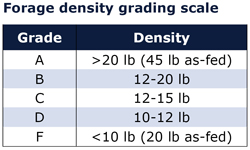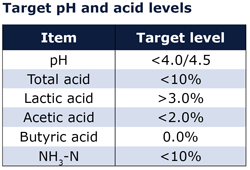
Decrease dairy cattle feed losses and earn the A on your forage harvesting report card
Posted on October 2, 2012 in Dairy Performance
 By Jon Urness With today’s dairy cattle feed costs, we need to get the most out of our homegrown forages. That means it’s not just back to school for our kids, but also back the basics when it comes to forage harvesting and storing nutritional food for your cows. Let’s see if our efforts will earn an A on this year’s report card. So here are your graded subjects and a few notes for making the grade: Density Research shows good packing decreases dry matter losses. Here’s the grading scale for forage density:
By Jon Urness With today’s dairy cattle feed costs, we need to get the most out of our homegrown forages. That means it’s not just back to school for our kids, but also back the basics when it comes to forage harvesting and storing nutritional food for your cows. Let’s see if our efforts will earn an A on this year’s report card. So here are your graded subjects and a few notes for making the grade: Density Research shows good packing decreases dry matter losses. Here’s the grading scale for forage density:  Fermentation analysis Your target pH should be less than 4.0 to 4.5. In an ideal fermentation, lactic acid is the most abundant acid produced. Therefore, moderate levels of lactic acid indicate good fermentation. You’ll notice this acid by its sweet, fresh smell. In contrast, high levels of acetic acid – commonly associated with a vinegar smell – indicate an inefficient fermentation and dry matter loss. Which means less feed for your dairy cattle. An exception to this is a silage where a more “controlled” fermentation has occurred due to inoculation with Lactobacillus buchneri. Butyric acid is especially bad news. It carries a rank, rancid or fishy smell. Produced through poor fermentation, butyric acid means loss of forage dry matter and quality nutrition for your cows. Forages can also undergo extensive protein degradation, resulting in a loss of protein quality. Cows consuming silages with higher butyric acid content may have lower dry matter intake and lower energy intake. These forages can also cause ketosis when fed, especially immediately post-fresh. These are the target pH and acid levels that will earn you a top grade:
Fermentation analysis Your target pH should be less than 4.0 to 4.5. In an ideal fermentation, lactic acid is the most abundant acid produced. Therefore, moderate levels of lactic acid indicate good fermentation. You’ll notice this acid by its sweet, fresh smell. In contrast, high levels of acetic acid – commonly associated with a vinegar smell – indicate an inefficient fermentation and dry matter loss. Which means less feed for your dairy cattle. An exception to this is a silage where a more “controlled” fermentation has occurred due to inoculation with Lactobacillus buchneri. Butyric acid is especially bad news. It carries a rank, rancid or fishy smell. Produced through poor fermentation, butyric acid means loss of forage dry matter and quality nutrition for your cows. Forages can also undergo extensive protein degradation, resulting in a loss of protein quality. Cows consuming silages with higher butyric acid content may have lower dry matter intake and lower energy intake. These forages can also cause ketosis when fed, especially immediately post-fresh. These are the target pH and acid levels that will earn you a top grade:  Microbial counts Yeasts and molds can grow out of control in a short amount of time. In fact, the populations can double each hour. That means that if you have 100,000 colony forming units (CFU) per gram of TMR at breakfast, you’ll have 32,000,000 by lunch. That’s why it’s good to have a handle on your microbial counts and provide the right environment for a good fermentation. You’ll get an A in this subject if you can keep your yeast levels below 100,000 cfu/g and molds below 10,000 cfu/g. Temperature report Differing temperatures throughout the bunker indicate differing levels of fermentation. An A-earning bunker will show no “hot spots” on an infrared image. It will also have core temperatures less than 75°F. Remember, core temperatures are largely dependent on ambient temperature on harvest day, so they may be higher than this ideal level. Core temperatures that are higher than temperatures on the edges mean you have a stable forage. You also want cool faced feeds. Finally, the surface temperature of the bunker should not range by more than 15°F. Have more questions? You tell your kids to ask questions if they want to learn more in school. The same rules apply here. This Forage Benchmarking Report Card will be a major focus in the Vita Plus booth at World Dairy Expo (Booth 1801-1902 in the Exhibition Hall). Stop by to chat with a consultant and learn more. And if you can’t make it to Expo, don’t worry. Contact your consultant or dealer representative directly and we’ll work with you to help you get a straight-A forage harvesting report card. About the author: Jon Urness is the Vita Plus national forage specialist. He grew up on his family’s five-generation homestead dairy near Black Earth, Wis. and still lives there today. He graduated from the University of Wisconsin-Madison in 1977 with a bachelor’s degree in agricultural journalism. Since 1992, Urness has provided on-farm dairy nutrition consulting in southwest Wisconsin as a Vita Plus employee owner. He has also taken on the forage marketing responsibilities outside of the traditional Vita Plus market.
Microbial counts Yeasts and molds can grow out of control in a short amount of time. In fact, the populations can double each hour. That means that if you have 100,000 colony forming units (CFU) per gram of TMR at breakfast, you’ll have 32,000,000 by lunch. That’s why it’s good to have a handle on your microbial counts and provide the right environment for a good fermentation. You’ll get an A in this subject if you can keep your yeast levels below 100,000 cfu/g and molds below 10,000 cfu/g. Temperature report Differing temperatures throughout the bunker indicate differing levels of fermentation. An A-earning bunker will show no “hot spots” on an infrared image. It will also have core temperatures less than 75°F. Remember, core temperatures are largely dependent on ambient temperature on harvest day, so they may be higher than this ideal level. Core temperatures that are higher than temperatures on the edges mean you have a stable forage. You also want cool faced feeds. Finally, the surface temperature of the bunker should not range by more than 15°F. Have more questions? You tell your kids to ask questions if they want to learn more in school. The same rules apply here. This Forage Benchmarking Report Card will be a major focus in the Vita Plus booth at World Dairy Expo (Booth 1801-1902 in the Exhibition Hall). Stop by to chat with a consultant and learn more. And if you can’t make it to Expo, don’t worry. Contact your consultant or dealer representative directly and we’ll work with you to help you get a straight-A forage harvesting report card. About the author: Jon Urness is the Vita Plus national forage specialist. He grew up on his family’s five-generation homestead dairy near Black Earth, Wis. and still lives there today. He graduated from the University of Wisconsin-Madison in 1977 with a bachelor’s degree in agricultural journalism. Since 1992, Urness has provided on-farm dairy nutrition consulting in southwest Wisconsin as a Vita Plus employee owner. He has also taken on the forage marketing responsibilities outside of the traditional Vita Plus market.| Category: |
Dairy Performance Forage harvesting |

